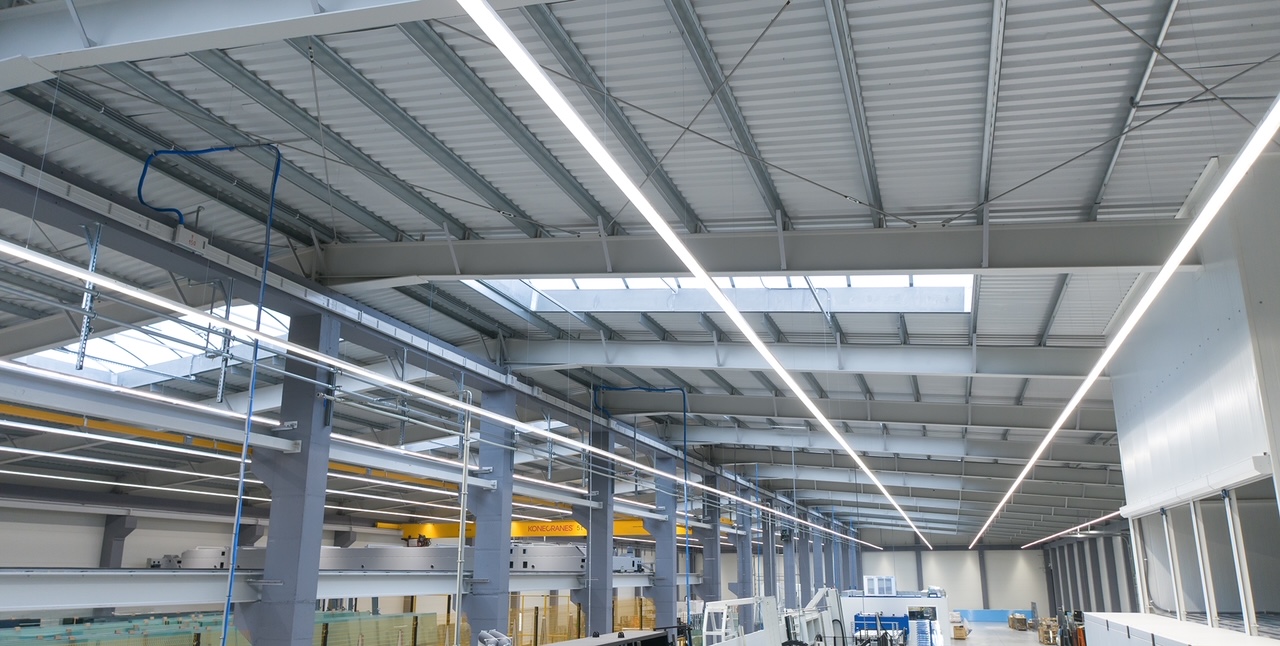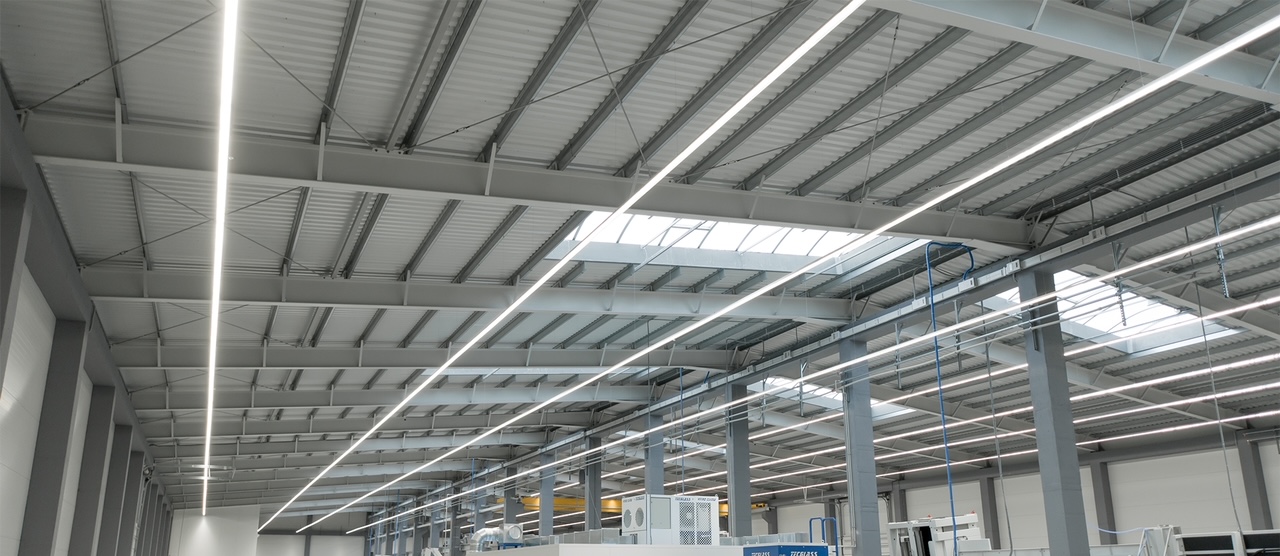Hall lighting
Production, warehouse and industrial halls are specific spaces that require an appropriate approach to lighting. Their surface and limited access to natural light are a huge challenge. When designing and creating lighting systems for halls, it is worth paying attention to several issues. We should not only take into account occupational health and safety standards, but also the needs of specific workplaces, and choose solutions that will be energy-saving and economical.
Lighting standards for halls
In accordance with the Regulation of the Minister of Labor and Social Policy on general occupational health and safety regulations, there must be adequate lighting in production, warehouse and industrial halls. It is intended to ensure proper visual conditions and safety during the activities performed by employees.
The standard that regulates these issues is PN-EN 12464-1:2011 (formerly PN-EN 12464-1:2004). It contains information on hall lighting, including the main parameters, including:
light intensity and uniformity;
the color of light along with its transmitting coefficient.
It is on their basis that lighting systems should be created that will support employees in their work. The way they are designed determines not only the comfort and safety of employees, but also the efficiency and the number of mistakes that may occur during work (e.g. when packing orders or checking manufactured components).
If you want to create a new hall lighting system or improve the existing one, it is worth performing a specialist audit. As part of it, specific rooms and spaces will be assessed in terms of electricity consumption for lighting. The effectiveness of lighting fixtures and lamps in the context of employee and production efficiency will also be examined.
Based on the audit documentation, we will be able to create a new lighting system design or modernize the existing one. Experts in the form of architects, constructors and engineers specializing in lighting devices can help us in this type of work. They have the necessary equipment and knowledge that will enable us to create a system tailored to the needs of our hall and the requirements of our employees.

What light intensity should there be in halls?
Taking into account the previously mentioned standards, the light intensity in halls can range from 200 to even 1,500 lux, depending on the individual requirements of the facility or workplace. An example division by specific positions looks as follows:
- computer-aided design station (work in front of a computer screen) – approx. 500 lux;
- welding/soldering – approx. 300 lx;
- precision assembly works – approx. 750 lux;
- micromechanics – approx. 1000 lux.
Other lighting parameters should also be determined in a similar way. In the case of light color, it should be adapted to specific production conditions. If manual activities are performed at workstations, they must ensure high visual efficiency. Then its value should range from 4500 K to 5000 K.
Another important parameter is the glare factor (UGR), which indicates the amount of blinding glare emitted by light. The higher the UGR values, the greater the discomfort caused by the lamps. It is assumed that in rooms where work requires precision, its coefficient should be low. In the case of warehouse halls, the UGR value should be <22, and in the case of production halls, <25.

Maintaining the above parameters is particularly important in the context of halls, because in their case access to natural light is significantly limited. This results in more frequent cases of employee fatigue, as well as drops in efficiency. If possible, it is worth using light bulbs that emit light of a neutral color, similar to natural light.
Features of good industrial lighting
Modern industrial lighting for production and warehouse halls, in addition to the ability to set specific lighting parameters, should also have other features. The most important of them include:
- high performance;
- energy efficiency;
- durability;
- possibility of combining into larger systems.
All of these functions are fulfilled by modern LED lighting, which is chosen by many owners of industrial and production spaces. Lamps and lighting fixtures compatible with this technology guarantee high quality of light and efficiency. At the same time, they are safe for the environment and humans, and also allow for savings in terms of electricity bills.
Lighting solutions based on LED technology are also recommended due to their relatively low prices. This is important when creating larger systems consisting of many lamps and luminaires, as well as when it is necessary to replace broken or damaged components.
The industrial environment is very demanding on machines and equipment. Lamps operating in the halls must be fully operational and should provide light sometimes 24 hours a day to ensure proper working and production conditions. That is why their durability and resistance to mechanical damage, heating and external factors (e.g. dust and pollution) are so important.
Production and industrial halls are also large spaces, which means they have a significant need for lighting. In their case, the perfect solution will be devices that can be combined into systems, as well as fixtures that allow you to create strings and connect them to busbars. Thanks to this, we can illuminate the entire hall, including workstations, communication routes, shelves and entrances.

The best lamps for hall lighting
If you are designing or creating lighting for your industrial or warehouse hall, be sure to consider solutions using modern LED technology. We especially recommend DALI system products, which include, among others: LED power supplies, sensors and relays. Products of this brand are easy to install and resistant to all types of interference. Their communication network consists of two low-voltage lines that are also signal and power cables. Communication between the end element and the control unit is bidirectional, so you will be able to control and diagnose it.
The main benefit of DALI systems is the ability to create a central point for managing the lighting of the entire facility. In the case of large hall buildings, it is possible to connect over 12,500 lighting devices. The DALI system also operates in a wireless variant, which allows the lighting of large areas with limited space for the bus. It consists of wireless power supplies, sensors and switches connected to the IP gateway.
DALI is a functional solution dedicated to industrial, production and warehouse halls, which allows, among others:
- constant control of light intensity;
- individual or group control;
- smooth on and off;
- dimming of individual luminaires and motion detection;
- implementing time functions based on schedules;
- control using an astronomical clock;
- diagnostics of luminaires and the entire system.
DALI systems work perfectly with other devices thanks to new generation sensors. After appropriate programming, they can control, among others: air quality in the hall and connect to the software responsible for building management. Then we can connect lamps and luminaires with the air conditioning system and the roller shutter and door control system.
You will find these and other solutions compatible with LED technology at LAKO! Since 1982, we have been designing and creating innovative lighting solutions for individual clients and companies. In our portfolio you will find numerous projects that confirm our versatility and wide product offer. Please contact us!
